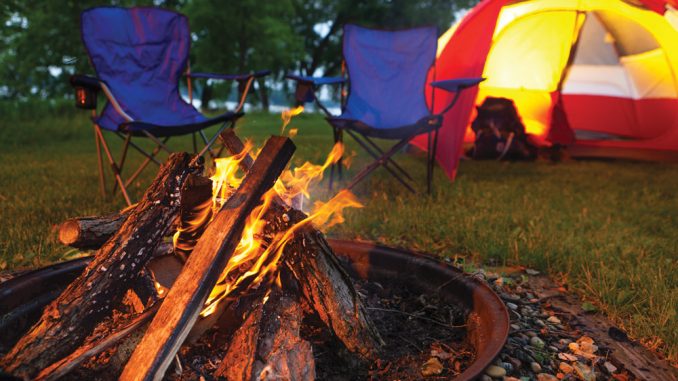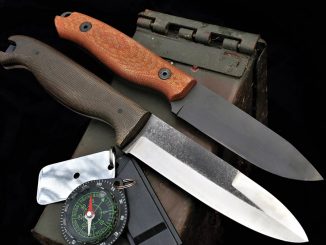
These days, there are a lot of good reasons to increase your personal survival quotient. And, there are several distinct benefits to creating a “survival camp”, right in your own backyard.
Once you create a backyard camp, you can use it to teach your children survival skills without having to take all the extra time, along with the expense of travel, that going to a remote camp might require. You can teach your children the essential skills that will help them lifelong and let them have a great time learning it—all in the comfort and safety of your own backyard.

A tepee in a hilly, urban backyard of Los Angeles. To the south are the downtown skyscrapers. A man lived in this tepee for two years and was self-contained, except for the toilet.
A backyard camp is a learning tool for your children, and it provides you with a way to test out your equipment and—more importantly—your skills. Depending on how you set this up, you’ll be able to regularly try things out and improve your skills, just by going into your own backyard.
What’s a Backyard Survival Camp?
Think of it this way: Your home was just ravaged by an earthquake, and it’s unlivable. There’s no power, and the gas is out. You’re now going to be living in the backyard camp that you set up so long ago.
You’re going to need everything you’d have in a camp in the woods, and it all needs to be self-sustaining. You’ll need a shelter, a toilet, a way to cook, a way to wash and, somewhere nearby, a supply of water, food, basic hygiene gear—and probably some tools.

Learn how to set up a tent. Consider keeping one in your backyard camp

Instructor Keith Farrar shows how to turn a grommeted tarp into a quick shelter.
If you’re any sort of camper or prepper, you probably already have all the elements of this camp here and there in your garage, closets and storage areas.
But now, we’re going to set it all up so you can “camp” in your backyard. You might be alone or with family and friends and for overnight, a short while or longer.
Let’s look at each part of the camp.
The Shelter
For most of you, this can just be a pop-up tent you purchased at a backpacking store. Even if you don’t plan to keep it up all the time, find a spot in your yard that’s level, perhaps shaded and where you don’t mind losing the grass or other ground cover under it.
If a nylon tent is out in the sun for prolonged periods of time, it degrades and falls apart in a year or so. The reason most tents last for years is because they’re used for just a few days once or twice a year, and then, they’re packed up and stored. However, if you’re going to keep the tent up more or less regularly, you’ll want to keep it out of direct sun and possibly also treat the fabric with one of various products on the market to protect it from the sun’s UV rays.

Actor Ed Begley Jr. poses with his solar-powered Sun Oven in his backyard.
Wherever you set it up, it should be convenient, and its floor should be flat. It’ll be used primarily for sleeping and just as a place to stay if it’s raining or snowing outside.
Your shelter can also consist of a large tarp stretched out like a canopy to provide a roof over your head. This requires a good tarp, cordage, some trees and maybe some tent pegs to tie it to.
A friend of mine has a large backyard in which he set up a 17-foot-diameter tepee. Inside is a sleeping area and a central fire pit for cooking and warmth. Essentially, he’s already got the major elements of his backyard survival camp in place!

Cooking on rocks is easy and inexpensive to set up in a backyard camp.
Cooking
Cooking outdoors is easy on a grill that’s placed on rocks, but you also need to have a supply of firewood to burn. Firewood is easy to come by, and it needn’t be large. Small twigs start easier; and, if you’re just heating a small meal, a handful is usually enough to heat coffee or soup. Keep your firewood up off the ground and covered to protect it from the rain.
Nevertheless, cooking with an open fire can “get old.” You might consider having a barbecue handy, as well as a hibachi. Both of these are easy to cook on, easy to store and require minimal fuel for cooking. Maybe you want something more like your kitchen stove. I’d suggest a Coleman camping stove, which typically has two burners and requires a can of fuel. These are durable, long lasting and easy to operate. In addition, you’ll need a box where you keep a few pots and pans, as well as whatever supply of food you intend to cook and eat.

A view of a tarp shelter. This simple shelter can be set up anywhere a taut cord can be stretched horizontally.
Most camps have a fireplace as a central attraction. It might also be the spot where the cooking is done, but it tends to be the place where people gather for breakfast and dinner. Keep this in mind when you plan your backyard survival camp.
Even if you have a little cooking area, such as on a table, you should consider having a central fire area where everyone meets, eats and talks. Think of it as your outdoor “living room”—the place where everyone gathers.
Cleanliness
We’ve sometimes found old, discarded sinks placed on the street. We’ve taken them, built a frame to hold them up and used them to wash food, dishes, clothes or our hands. If you have the space, this is worth having in your backyard.
Another necessity is a shower. In the past, we’ve heated water in a can and then taken a “shower” with a half-gallon of hot water and a wash cloth. However, these days, solar showers are sold everywhere, and they’re highly recommended. I wouldn’t leave home for a camping trip without one, and I always keep one at home for possible backyard use. Solar showers consist of a container you fill with water, put in the sun for a few hours until the water’s hot and then hang up to take your shower. They come in various sizes, and I think the 2.5-gallon size is ideal, in terms of weight and the time it takes to heat the water. I’ve seen smaller solar showers, as well as those that hold up to 5 gallons. However, 5 gallons is too heavy, and it takes too long to heat up. On the other hand, the smaller ones are usually a frustration when you run out of water. More-elaborate models can include a heating component or a pump.

A rain collection system, such as Kevin Sutherland’s, is a great addition to your backyard camp.
Also consider purchasing one of the inexpensive pop-up curtain tents that are made specifically to give you privacy when showering. They’re not expensive. Alternatively, you can fabricate a privacy screen with an old bed sheet and some cordage.
Toilet
There are several possibilities for a survival camp toilet. The easiest, of course, is just a hole in the ground that you cover with some soil after each use. Location is critical for privacy and other concerns, such as the underground water supply. The details of how you set up, use and clean an outdoor toilet will depend on several factors, including the need for privacy.
A bucket with a toilet seat cover is a bit better; it allows you to move it about as needed and then bury the contents as needed. (Of course, you could also dispose of the contents using your home’s toilet.)

A backyard garden is another great asset to create as part of your backyard survival camp.
These days, backpacking and camping stores sell a variety of camping and “emergency” toilets that are useful for car-camping or camping in the backyard. These are worth considering. (And don’t forget to stock up on a little extra toilet paper.)
Keep in mind that using a backyard privy is probably against the health codes of most areas, so you’ll want to do this in a way that doesn’t draw attention, cause odors or attract insects. If a neighbor becomes aware of your facilities, let them know the occasional use of a backyard toilet is part of your “survival education” process.

This cover for your solar shower provides some discreet backyard showering privacy.
Just in Case …
A backyard survival camp provides a lot of benefits. It allows you the luxury of testing your gear and sharing and improving your skills, and you might actually have to use it in a real emergency.
You might build something very temporary or more permanent, depending on your particular situation, including yard size, legal or homeowner association limitations, visibility by neighbors and other unique factors. You might also choose to modify it as needs change and you cycle through your gear.
However, for as long as you have this resource, it’ll be an asset for everyone who uses it.

A solar shower is a must-have for a backyard survival camp. Various designs are available from a number of manufacturers.

This is the Dietz lantern, which has an optional top fixture that can be used for cooking.

If you have the time and resources, a more-traditional, longer-lasting shelter can be constructed.

Be sure to have plenty of firewood set aside for your outdoor cooking and campfire.

A Coleman gas stove is a good choice for those looking for a dependable and familiar way to cook outdoors

A mosquito net is a good idea if you’re in a hammock in the summer.

Setting up a sink in your backyard has many benefits.

This is a simple bucket toilet you should consider having as part of your backyard camp. The seat can be mounted on virtually any plastic 5-gallon bucket.

Wood chips or shavings are ideal to add to the toilet after each use.
Editor’s note: A version of this article first appeared in the October, 2020 print issue of American Survival Guide.





Be the first to comment